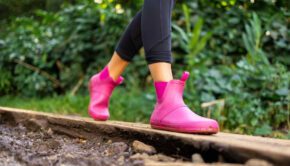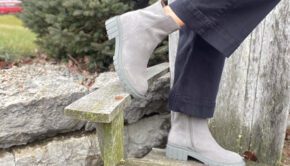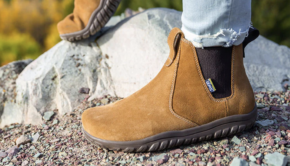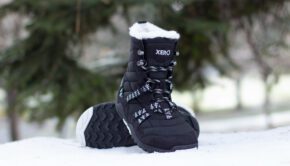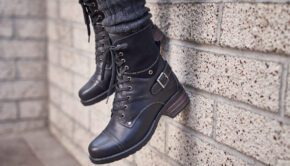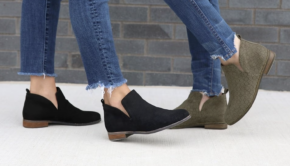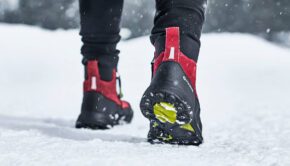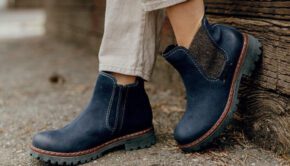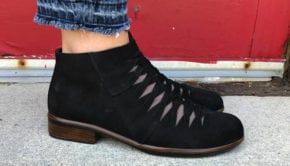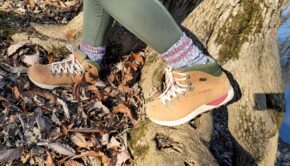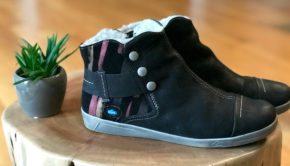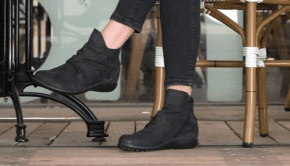

Browsing the "Comfortable Boots for women" Category
6 Comfortable Rain Boots For Picky Feet
February 2nd, 2024 | by Kirsten Borrink
You don’t even need to be a HSP (highly sensitive person) to absolutely detest the feeling of soggy socks–wet feet
Blondo Prestly Boot Review: Foot-Friendly and Waterproof
January 20th, 2024 | by Kirsten Borrink
What to wear when the forecast is calling for more gray, rain, cold, and you’re sick of wearing your snow
Comfortable Chelsea Boots: 9 Stylish Picks for Problem Feet
January 20th, 2024 | by Kirsten Borrink
At last, a recurring trend we achy-footed gals can get behind: the Chelsea boot. Credited to Queen Victoria’s shoemaker, the
8 Sensational Snow Boots Surround Feet in Comfort and Warmth
January 15th, 2024 | by Kirsten Borrink
Growing up in Indianapolis in the seventies, we didn’t just get snow, we got blizzards–a few famous ones at that.
Taos Crave Boot for Taking on the Day in Comfort and Style
January 10th, 2024 | by Kirsten Borrink
This review of the Taos Crave boot is sponsored by TaosFootwear.com. The opinions are completely my own based on experience. This
Dr. Scholl’s Shoes Rate Bootie Review
January 10th, 2024 | by Kirsten Borrink
I’m excited to tell you about Dr. Scholl’s Shoes Rate bootie. I ordered it on a whim because, well, it’s
Icebug Boots for Safety on Slippery Surfaces
October 24th, 2023 | by Kirsten Borrink
The Icebug Ivalo-L with BUGrip is a fascinating little boot. Yes, it’s lightweight, warm, roomy in the toe, and
6 Cute, Comfortable Ankle Boots Bring Blissful Relief to Problem Feet
October 20th, 2023 | by Kirsten Borrink
Ankle boots have established themselves as a wardrobe staple deserving of top-shelf status right next to tall boots. In fact,
Naot Leveche Review: Walk a While in This Woven Wonder Bootie!
September 9th, 2023 | by Kirsten Borrink
Naot Leveche booties provided by Naot. The opinions are completely our own based on experience. When I first opened the box containing
Comfortable Ankle Boots and Shooties
September 5th, 2023 | by Kirsten Borrink
Cover up your cankles in comfort and style in one of these sweet little boots. Even if you’re blessed with
Loving My L.L. Bean Hiking Boots! Kirsten’s Review
January 12th, 2023 | by Kirsten Borrink
You would think as a comfortable shoes reviewer I’d have multiple pairs of hiking boots in my closet, but I
Cloud Footwear: Comfortable Shoes for Everyday Adventurers
December 5th, 2022 | by Beth Bengtson
This review of Cloud Footwear Aline and Aika is sponsored by Cloud Footwear. The opinions are completely our own based on experience.
Naot Kahika Bootie: One Teacher’s Rave Review
September 20th, 2022 | by Kirsten Borrink
This review of the Naot Kahika bootie is sponsored by Naot.com. The opinions are completely our own based on experience.
When choosing a new pair of boots it can be a challenge to find a style that is cute, functional and at the same time comfortable. For us ladies with problem feet the search for the right boots can be even more difficult. The cute pair we see online or on the rack may be terrible to wear when actually on our feet. The struggle is real but barkingdogshoes.com is here to help with comfortable and surprisingly nice looking styles in all boot types. It’s worth taking a few minutes to browse our reviews.

We’ve found stylish, comfortable boots for all seasons
After all, if you live in Chiberia or cooler climates, boots may carry you through 2-3 seasons, much more than summer sandals or even cute flats that I may keep in the closet. According to the American Orthopedic Foot and Ankle Society, boots not only protect our feet, they also cushion our body weight. This doctor’s group says finding the proper footwear and making sure they fit well is one of the most important things you can do to keep your feet and your body happy.
How to shop for comfortable boots
So how do you find the boots that can make your feet happy? Sorting through hundreds of boot styles and heel heights can be a challenge. At barkingdogshoes.com I’ve spent lots of time sorting through products to help identify boots options that not only look nice but are also comfortable. Here are some things I consider when shopping for comfortable boots.
1. Leg Shape First up, what is your leg shape? (wider, athletic calves or narrow calves anyone? When I’m shopping for boots I usually want a certain look of leggings or skinny jeans tucked into my cute boots. I don’t actually wear skinny jeans but I often pick knee high boots for the style. Depending on your calf size you’ll want to look for some goring. A lot of boots have elastic goring hidden behind some leather or it takes up a whole panel across the back. You may also see a buckle that allows you to take in or let out a little leather in the fit. Another tip, some cute styles come with extra stretch or adjusters in the calves that give you additional room without looking like it. Boot manufacturers are beginning to make more specifically designed boots for wider calves and boots for narrow calves. If you shop online you’ll find a lot more options in wide calf or extra wide calf. Zappos.com has sections devoted to it. It didn’t used to be this way but in the past two year probably 80% of U.S. shoe makers have added boots to fit more athletic calves. We aren’t seeing as many choices from Europeon makers as of yet, but they’re out there. For a few tips on how to properly measure your leg for women’s boots, check out this boot fitting guide from Nordstrom.
2. Orthotics and padding If you have problem feet, you need to consider the ability to add orthotics and additional padding to your boots. If I want to be able to wear an insole for my achy feet I’ll reach right in the boot I’m considering and see if I can pull out the insole it comes with. And remember, if you add an insole you may have a challenge getting the boot on because boots have a fitted feeling around the foot and ankle. If you’re shopping online, many manufacturers will say if the boot has a removable insole. Some have added orthotic-friendly categories on their sites. Check out my reviews here.
3. Toe Box You should also consider the toe box. According to experts, some pointy styles include a narrow toe box which could force the foot into an unnatural position, leading to painful steps or even morton’s neuroma. A narrow toe box may also squish the toes together and could make you less stable while walking. I generally stay away from pointy toes. I’ve posted reviews including the best boots for bunions with boots that all have wide toe boxes or material that stretches easily. With other boots, you won’t truly know how the toe box is shaped until you try a boot on. That’s one of the reasons I love ordering online- you can order three pairs and return two, to ensure you get comfortable fitting boots.
4. Traction and warmth Other things you may wish to consider include the sole and warmth. Does the boot you love have the traction you need for weather conditions? How about a sole that can handle the purposes you’ll need the boots for (slippery train platforms?). I look for a rubber outsole, even if it’s topped by a stacked wood heel for instance. While you’re boot shopping, look for wording about non-skid traction. And finally, consider if the boots are warm enough for outdoors but not too warm for all day wear at the office.
5. Foot type Do the boots fit your foot type? If you have high arches or flat feet, is there an insole that works for your foot? A super high heel may be an issue. If you have foot problems you don’t want to be wearing more than a one and half inch heel to avoid putting too much pressure on your forefoot. That’s true of any shoe I recommend unless it has a platform. The platform sole is going to raise your forefoot up. So when you go to a heel you can get more height in your boot with less incline from heel to toe. Sometimes a wedge heel may work by giving you height but still a supported foot. The advantage to a wedge heeled boot is your boot is completely flat against the ground, even with some height in the boot. Check out this cob hill bootie with its wedge and rubber sole.

Don’t forget to try on boots with the socks or tights you’ll be wearing in them.
6. Socks Take the socks with you that you’ll be wearing with your boots. You’ll want to try your thick socks to see if the boot fits around them. If you need more room in the calf, perhaps shorter athletic ankle socks might work in boots for you better than wearing knee socks.
7. Ankle support If you have a wider ankle or you want to feel secure around the ankles, look for boots with laces, like a combat boot style. This style can also help when you need an overall adjustable width. Sometimes the calf of a boot comes in extra wide but the foot part doesn’t. Today’s lace up boot styles can even look dressy with their bright color choices. I’ve found some combat style boots that zip up the back instead of requiring you to lace them up everytime. But you can still adjust the fit with the laces.
Types of Boots for Women
With their ability to protect feet and ankles, it is no wonder that experts says boots have been around for more than a thousand years. Boots come in all styles but most have a specific function. Here’s a quick overview of the types of boots for women:
Snow Boots: These boots are typically constructed with warmer lining materials, many have waterproof outsides, and they may be taller to help you trudge through the white stuff. They protect your feet from wet and cold weather. Did you know we’ve even sorted out the best snow boots for problem feet? Check out my reviews.
Rain Boots: Often made of rubber or plastic materials, rain boots are usually waterproof, although I see styles that are only waterproof up to their decorative stitching so check. Typical rain boots have little to no padding or support for your feet on the interior. But check out my review on a rain boot that allows you to add your own orthotics or insert. One other note, rain boots will not keep your feet warm without adding a pair of thick socks or tights.
Fashion Boots: A huge category of boots for women are fashion boots, which soared in popularity for mainstream adult women in the 1970’s and have stayed on trend during winter months ever since. A lot of women tell me they just feel more comfortable wearing boots. But why is that? I love how my foot feels in a boot because my ankle is so supported and I’m not getting that twisty feeling around my ankle I sometimes get in a shoe.
Fashion boots are usually constructed from leather, suede or artificial material. Fashion boots may be a zipper or pull on style. Fashion boots may offer extra detailing such as fringe, buckles or decorations. They may have a spike heel, platform or flat sole. Knee high fashion boots are a wardrobe staple for many women wearing skirts and dresses, or leggings with tunic tops to work or play. The shaft can be fitted, straight or slouchy fitting. Equestrian style boots usually reach your upper calf or knees. They are usually a low heel and can have a variety of details at the top. Chelsea boots are a classic trend in boots. This type of boot reaches your lower calf, usually has a flat sole or low heel and u-shaped elastic insert from the top of the boot down to approximately your ankle, to help you put on and remove the boots.

Timberland Savin Hill Chelsea Boot
Booties, a popular style trend in the past few years, are a short boot that hits just below your ankle. Booties can have a high or low heel.
Ankle boots may provide the support and feeling of a boot that women are looking for without covering their leg. I’ve posted about cute comfortable ankle boots that a reader with bunions swears by.
Work and Hiking Boots:
Among the other major types of boots are work boots and hiking boots, usually crafted with thick hard soles and reinforced toe caps. They are in more limited styles and built of durable materials. But they can still be cute, see my review and nice photos from Sedona, AZ! Most boots for work or hiking have laces to ensure a proper fit that will support your ankles and not rub.
Comfortable boot ideas for women
At BarkingDogShoes.com we’ve field tested thousands of shoes and boots and posted reviews to help make your search for comfortable footwear easier. Here are some of my favorite boots for women with problem feet.
As a general rule, some of the better comfort brands such as Dansko and Naot, make pretty fashion boots that are going to offer roomy toe boxes and removable foot beds. Merrill boots are outdoorsy but also cute. Keens tend to run wider (big plus for feet with bunions).
We hear from a lot of women searching for the popular tall style boots that will fit not only their feet but also their calf, whether wide or narrow. To find your calf size where boots are concerned, wrap a non-metal tape measure around the widest part of your calf. We’re happy to share ideas on wide and narrow calf tall boots.
More companies are joining the trend of wide calf boots. As I wrote recently, when Dansko finally gets on board and offers a wide calf boot option, it’s my job to tell you!
Many boots can be turned into comfortable boots for women with foot problems if they would just fit your orthotic. We’re full of ideas! Here are five orthotic friendly boots. Do you like the taller equestrian style boots? Check out a few equestrian styles that can accommodate an insert. Occasionally orthotics are even included by manufacturers, like this bootie with built-in orthotic.
Bunions got you considering hanging up your boots? Here are our top picks of the best boots for bunions.
Next up are snow boots. When the temperatures turn chilly and the ground is covered in white, those of us who have problem feet can still be comfortable and stylish. Check out our suggestions of the best snow boots for problem feet.
Contact us
Send your questions or share your comfortable boot favorites!
I hope among the many reviews you can find the right pair of comfortable and cute boots for your feet. Have questions about comfortable boots or want to share your latest boot find with us? Contact me with your question or comment.
Related links:
• 10 points of proper shoe fit on Footcaremd.com, the consumer website of the American Foot and Ankle Society

